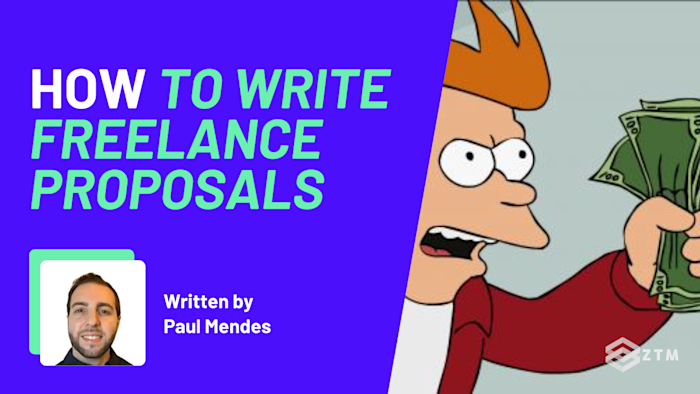Competition for clients can be tough.
The last step at securing them, is creating a kick-ass freelance proposal, but the thing is - almost everyone is telling you the same wrong things.
Well, not wrong exactly but just skimming the surface of whats needed. Sure a template helps, and A.I tools can definitely make it faster and easier when used properly, but speed isn't the issue.
Our goal is not to shotgun out 1,000 proposals and land 50 clients. Its to send 100 proposals and land 80+ of them.
- But what should you include in your proposal?
- Can it be just a simple paragraph about the service and your fees?
- Or do you need more if you want to seal the deal?
Tl;dr: The key is to create a freelance proposal that not only demonstrates your skills and experience but also connects with the client's needs and requirements. When done right, your proposal will showcase your value and make the client eager to work with you.
So, whether you are a full-time freelancer or a side hustler, investing time and effort into perfecting your proposal writing skills is a wise move that can pay off in the long run.
With that in mind, here are 9 tips that you can use to write a successful freelance proposal.
Tip 1. Understand your client's needs
Take the time to research the client and their project to ensure that you are proposing the best solution for their needs. By understanding their requirements, you can tailor your proposal to meet their expectations.
For example:
If the job post says that the client needs a new website, go ahead and research their current website to see what improvements can be made.

And as an added bonus?
Be sure to ask them specific questions about their desired design, functionality, and target audience to make sure your proposal addresses their needs.
It shows that you not only paid attention and have expertise, but that you’re also interested in their needs.
Simple right? It seems obvious but so many people forget to do this.
A common complaint that most people have when hiring freelancers (and why they turn their applications away) is a lack of context to the actual thing they want to hire for, or even a minimum of effort shown.
What like?
Well, often bad freelancers will just send copy and pasted applications from other jobs that don’t hit on anything that the customer talked about or wanted.
Other times they don’t even read the application before applying and get the person’s name wrong that they are sending the application to, or worse, apply for the wrong job entirely!
tl;dr:
Don’t be lazy here. Understand the customer and make your pitch unique to them. It’s the easiest way to stand out.
Tip 2. Define your proposal structure
Although you should never copy and paste a proposal application, that doesn’t mean that you can’t make your life easier by creating a proposal outline.
This way you can use the outline as a template for all new clients, and fill out the details required - saving you a heap of time, while also making sure you hit on and provide key materials and necessary topics, such as:
- Cover letter and introduction
- Their project / Your proposed services with tiered options
- Your working process and deliverables
- Qualifications and previous work/testimonials
- Pricing
- Working Terms and Conditions
- How to move forward and book in / next steps
- How to contact you
This way the customer always gets what they need, you never forget anything or have to write from scratch, and the proposal has a more professional look and feel.
You can even mock up a fancy cover design and editable sections in Adobe if you feel like it, and then have each section ready to fill out.

Speaking of which…
Tip 3. Make a great first impression
The cover page is the first thing the client will see, so make sure it is professional, eye-catching, and personalized. Stand out from the competition by showing that you have put in the effort to create a unique and tailored proposal.
For example:
To look more professional, use a cover page that showcases your branding and highlights your strengths. Consider thinking outside of the box and using all the tools you have at your disposal to create winning freelance proposals.
The one I shared above is customizable, but you could also add in other details such as a logo.

Don’t have photoshop skills?
You can always use Canva instead of Adobe, and then drag and drop to customize one of Canva's templates instead.

Tip 4. Reframe your services and qualifications
When providing a description of your services, it's important to focus on the client's needs and how you can provide value.
Instead of simply listing out your services and qualifications, try to frame them in a way that shows how they directly address the client's pain points or challenges.
For example
If you're a web developer proposing a new website for a client, don't just list out your technical skills and certifications.
Instead, explain how your experience in developing custom designs and creating user-friendly interfaces can improve the client's online presence and help them reach their target audience.
They don’t care about you. Not really. They care about their own needs, so if you can frame it less of an expense and more of a benefit, they’ll be more agreeable to your terms.

Suddenly your more expensive build option is more appealing, because they can see it from their point of view of how it helps them more.
Tip 5. Showcase your relevant work
Help build further trust in your ability to complete their project, by showcasing previous work.
However, take it a step further and provide specific examples or case studies of similar projects you've worked on in the past.
This not only demonstrates your qualifications but also shows how you have successfully tackled similar challenges in the past and can bring that expertise to the client's project.
When selecting examples of your previous work, choose projects that align with the client's industry or project type, and highlight your ability to solve similar challenges.
Pro tip:
Create a customized case study that showcases your work, highlights the challenges you overcame, and details the results achieved, and then provide this as an attachment to your proposal to help the client understand how you can add value to their project.

(Again, all doable in Canva).
You could even take it a step further and include a video introduction where you walk the client through your work and how it applies to their needs.
This can help you stand out from other freelancers and make a strong impression on the client, ultimately resulting in more successful freelance proposals.
Tip 6. Explain your process
Now that they trust you can do the job, their main concern is how will it work?
Do they just send you the money and hope it's done whenever you finish? Hopefully not!
Other than price issues, this is the last fear that a customer has before booking you for their project.
This is why you need to demonstrate to the client how you will collaborate with them to achieve a successful outcome, and provide a comprehensive plan that outlines the steps you will take to finish the project, including specific milestones or deadlines.
For example:
Detail the steps you will take to complete the project, such as:
- Week 1: Conducting research and designing mockups
- Week 2: Delivering the first draft and feedback/change requests
- Week 3: Delivery of final product
Super simple, but by providing a timeline for each step, you can give the client a clear idea of the project's progress, as well as what can be expected - and remove any anxiety.
Also? If there’s a clear set time for feedback and final changes, you won’t then get requests for other changes outside of the project timeframe and scope 😉.
Tip 7. Set your prices (and give them options)
OK so a few things here.
When the customer is looking for someone to complete their project, they will have a set budget with a range, and they don’t always want the cheapest option.
In my other guide, I talked about how to figure out what to charge, but I want to give you another tip.
Usually there will be a few people competing and sending a proposal across at the same time. That way the customer can weigh up each of the options.
So, a great way to stand out is to offer multiple options for your own work.
What do I mean?
Offer a tiered project delivery and pricing!
Give them the very best option with the premium pricing, a mid range option that hits their goals, and a lower tier option to still work with you at the lowest price but less work.
- Premium (Everything they want and more, with even better features) = $2,000
- Mid-Range (Everything they want) = $800
- Lower (Some of the things they want, but better than others would deliver) = $300
Obviously you would add more details than this, and write each section like a separate delivery section, but it helps frame your offer even better.
This way, they go from comparing you vs others, to comparing your options instead.
It becomes you vs you, instead of you vs them.
Smart eh?
It also helps to then set you in place as someone who can deliver, and also frames your middle option and lower options, even if more expensive than others, as a good price.
Also, sometimes the customer will simply want the premium priced option, and you could have missed out on money because you simply didn't ask for it!
They just didn’t realize it could be better than they originally planned and didn’t think to ask for those features.
Tip 8. Include project terms to cover you both
Ensure that both you and your client are protected by including a standard form of legal language in your proposal. This can cover essential details such as payment terms, intellectual property rights, and liability clauses.
Pro tip: Use a standard legal form, such as a contract template or terms of service, to protect yourself and your client.
Be sure to include clauses about payment terms, intellectual property rights, and project scope, so that you get paid properly for what is requested.
Your potential clients will appreciate this, as it feels like their back is covered and that you will deliver, but in reality, it also means you’re covered for payment and will remove scope creep (i.e. asking for more than they set out in the initial project).
Project scope is the bane of freelancing, and this one thing can change so much of your back and forth emails, almost overnight.
You can also improve your process by using some of the customer interaction techniques that bigger companies use. Basically, how to smooth out issues and improve your sales process
Tip 9. End on a high note
There are 2 vital things you need at the end of every proposal:
- A recap, and
- A call to action
The recap is there to maintain the momentum and create a sense of urgency. You simply end your freelance proposal by summarizing the benefits of working with you and thanking the client for considering your proposal.
Finally, provide a clear and specific call to action that encourages the client to take the next step, and how to take it.
For example:
"Thank you for considering my proposal. I believe my skills and experience are an excellent match for your project needs.
To discuss your project in more detail and explore how we can work together, please let me know your availability for a 30-minute phone or video call this week (provide a link to your Calendar).
I look forward to hearing from you and starting this project together."
Easy right?
You got them excited to work with you, so tell them how to do it and get them to move forward!
Now it’s time to write your own proposals
All in all, writing a successful freelance proposal requires a combination of creativity, strategic thinking, and professionalism.
By following the tips outlined in this article, you can increase your chances of crafting a winning freelance proposal that connects with the client's needs and helps you stand out from the competition.
Remember to take the time to research the client and their project, structure your proposal effectively, and showcase your experience and qualifications. Additionally, always be transparent about your prices and include legal language to protect both you and the client.
Finally, don't forget to send your proposal on a high note by summarizing the benefits of working with you and providing a clear call to action. By doing so, you can maintain momentum and encourage the client to take the next step.
P.S.
If you want a more detailed explanation on this entire process, with additional information and advice from someone who freelances for a living, check out my complete guide to freelancing course.
It will give you the step-by-step guide to go from ZERO EXPERIENCE to becoming a Freelancer and having a profitable freelance business getting clients you never thought possible.






